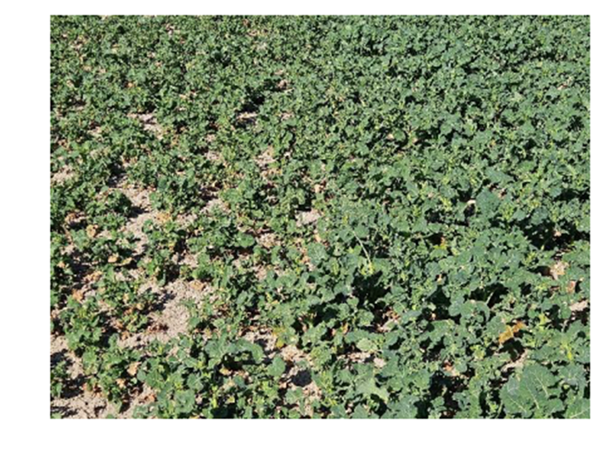This autumn has brought with it a wide spectrum of oilseed rape (OSR) crop development. We’re seeing everything from crops drilled in early August, now at 7–8 true leaves, to later-drilled crops from mid-to-late September that are only just showing their first true leaf. This spread in crop growth reflects the increasingly wide drilling window we’re seeing across the country.
Some growers began sowing at the start of August, while others were still drilling into late September, something made possible by the exceptionally mild and warm conditions this autumn. Driving around, it’s clear there’s significantly more OSR in the ground this year thriving, compared to recent seasons.
Strong Crops Moving Quickly – PGRs Recommended
Many of the earlier-drilled crops are powering ahead. For these forward crops, we’re advising the use of plant growth regulators (PGRs). The benefits of a well-timed autumn PGR include:
Encouraging strong root development
Helping the plant better withstand wet or dry conditions over winter
Increasing root collar diameter, improving tolerance to cabbage stem flea beetle (CSFB) larvae
Keeping the growing point closer to the ground to protect developing flower buds from weather exposure
These effects help build a more resilient plant going into winter, which is particularly important in seasons with such variable weather patterns. The PGR application timing can also be used alongside the autumn application of boron which is crucial for a strong Oilseed rape Root Development.
Flea Beetle Pressures Emerging Again
Unfortunately, the return of flea beetle pressure in late September has brought fresh challenges, particularly for later or slower-developing crops. The worst damage has been seen in split fields or where crops drilled at different times are adjacent to each other. In these cases, flea beetles seem to have migrated from stronger plants to smaller, more vulnerable ones, increasing damage levels.
While many crops had good moisture at drilling, allowing rapid establishment, smaller crops remain at risk from flea beetle pressure and should be monitored closely.
Phoma Making an Early Appearance
We’re also seeing phoma leaf spot creeping into some varieties, especially those relying on a single resistance mechanism. As always, it’s important to monitor crops and consider fungicide treatment where thresholds are met.
Grassweed Control – Timing is Key
Following recent rainfall and warm temperatures, many fields have seen a flush of grassweeds. This is adding to the complexity of autumn management, especially where crop growth stages vary significantly within a single field.
In some fields, we’re seeing a mix of plants at 1 true leaf alongside those with 4, 5 or even 6 leaves. This makes the timing of clethodim applications particularly challenging. Careful assessment of leaf stage and label guidance will be crucial to ensure effective grassweed control without risking crop safety.
In oilseed rape, clethodim should not be applied after 15th October or to crops with more than 6 true leaves, in-line with stewardship measures. For optimal results, applications should also be made in a minimum water volume of 150 L/ha, using a steady forward speed, and always use a true water conditioner that also has pH buffering properties, such as X-Change. Like many herbicides, clethodim is a weak acid and susceptible to lock-up in hard water. Uptake is optimised at pH 4.5 - 5.0. Using X-Change, which sequesters hard water cations and buffers pH will keep clethodim working effectively.
Follow-up propyzamide applications should then be applied at least 10-14 days after clethodim applications, but only when soil temperatures are appropriate to ensure best possible performance of propyzamide
Broadleaf Weed Control – Correct Hard Water
As well as clethodim, other systemic herbicides can be affected by water hardness. Efficacy of products containing synthetic auxins, such as picloram, aminopyralid and halauxifen-methyl in hard water areas can been improved by use of X-Change.
Cations, e.g. Ca2+ naturally present in hard water have a deleterious effect on herbicides, meaning a certain amount is lost to the formation of insoluble calcium salts. Correcting water hardness means 100% of the applied herbicide remains in a chemical form in which it is biologically active.
This is particularly beneficial where target weeds are considered 'moderately susceptible' to the herbicide, and a dose rate response may be expected.
Early Drilled Crops
Early drilled crops could benefit from an N-dose in the Autumn. Forward crops generally use the available nitrogen in the soil more quickly. A 30kg nitrogen application could be recommended but previous crops need to be taken into account and also the nitrogen immobilisation in the soil. Warmer autumns often mean that nitrogen can be more readily available to the oilseed rape plant. The nitrogen boost can help the plant recover from later flea beetle and pigeon attacks.
The Terres Inovia data from France (2025) has shown that an insecticide treatment in the autumn can reduce flea beetle and autumn stem weevil numbers so this could be considered.

In Summary
This autumn is highlighting just how variable OSR establishment can be, even within the same farm or field. While many crops are off to a great start, close attention is still needed on flea beetle activity, phoma risk, and weed management. For those with forward crops, a well-timed PGR could pay dividends in building plant strength ahead of winter.
If you’re unsure about the best approach for your field conditions, speak with your agronomist or seed specialist, tailored advice will be key to maximising crop performance this season.